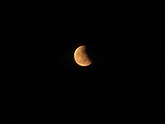November 2022 lunar eclipse
| Total eclipse | |||||||||||||||||
 From Aichi Prefecture, Japan at 11:04 UTC | |||||||||||||||||
| Date | 8 November 2022 | ||||||||||||||||
|---|---|---|---|---|---|---|---|---|---|---|---|---|---|---|---|---|---|
| Gamma | 0.2570 | ||||||||||||||||
| Magnitude | 1.3589 | ||||||||||||||||
| Saros cycle | 136 (20 of 72) | ||||||||||||||||
| Totality | 84 minutes, 58 seconds | ||||||||||||||||
| Partiality | 180 minutes, 50 seconds | ||||||||||||||||
| Penumbral | 353 minutes, 51 seconds | ||||||||||||||||
| |||||||||||||||||
A total lunar eclipse occurred on Tuesday, November 8, 2022. The southern limb of the Moon passed through the center of the Earth's shadow. It surpassed the previous eclipse as the longest total lunar eclipse visible from nearly all of North America since August 17, 1989, and until June 26, 2029.[1][2][3] Occurring only 5.8 days before apogee (on November 14, 2022), the Moon's apparent diameter was smaller. The next total lunar eclipse will take place on March 14, 2025.[4] A lunar occultation of Uranus happened during the eclipse.[5] It was the first total lunar eclipse on Election Day in US history.[6][7] This event was referred in media coverage as a "beaver blood moon".[8][9]
Visibility
The eclipse was completely visible over the Pacific and most of North America. It was seen on the rising moon in Australia, Asia and in the far north-east of Europe, and on the setting moon in South America and eastern North America.
 
|
 Visibility map |
Related eclipses
Eclipses of 2022
- A partial solar eclipse on 30 April.
- A total lunar eclipse on 16 May.
- A partial solar eclipse on 25 October.
- A total lunar eclipse on 8 November.
Lunar year series
| Lunar eclipse series sets from 2020–2023 | ||||||||
|---|---|---|---|---|---|---|---|---|
| Descending node | Ascending node | |||||||
| Saros | Date | Type Viewing |
Gamma | Saros | Date Viewing |
Type Chart |
Gamma | |
111
|
2020 Jun 05
|
Penumbral
|
1.24063 | 116
|
2020 Nov 30
|
Penumbral
|
-1.13094 | |
121
|
2021 May 26
|
Total
|
0.47741 | 126
|
2021 Nov 19
|
Partial
|
-0.45525 | |
131
|
2022 May 16
|
Total
|
-0.25324 | 136
|
2022 Nov 08
|
Total
|
0.25703 | |
| 141 | 2023 May 05
|
Penumbral
|
-1.03495 | 146 | 2023 Oct 28
|
Partial
|
0.94716 | |
| Last set | 2020 Jul 05 | Last set | 2020 Jan 10 | |||||
| Next set | 2024 Mar 25 | Next set | 2024 Sep 18 | |||||
Saros series
This eclipse was a part of Saros cycle 136, and the first of the series that passes through the center of the Earth's shadow. The last occurrence was on 28 October 2004. The next occurrence will happen on 18 November 2040.
Half-Saros cycle
A lunar eclipse will be preceded and followed by solar eclipses by 9 years and 5.5 days (a half saros).[10] This lunar eclipse was related to two hybrid solar eclipses of Solar Saros 143.
| 3 November 2013 | 14 November 2031 |
|---|---|

|

|
Metonic series
This eclipse is the third of five Metonic cycle lunar eclipses on the same date, 8–9 November:
The Metonic cycle repeats nearly exactly every 19 years and represents a Saros cycle plus one lunar year. Because it occurs on the same calendar date, the Earth's shadow will be in nearly the same location relative to the background stars.
|
|

|

|
Tritos series
- Preceded: Lunar eclipse of December 10, 2011
- Followed: Lunar eclipse of October 8, 2033
Tzolkinex
- Preceded: Lunar eclipse of September 28, 2015
- Followed: Lunar eclipse of December 20, 2029
Observations
Miami, Florida, 10:27 UTC
Merritt Island, Florida, ~10:30 UTC
Canberra, Australia, 10:48 UTC
Telescopic view from Changdao County, Shangdong, 11:03 UTC
Semporna, Malaysia, 11:16 UTC
Palangka Raya, Indonesia, 11:26 UTC
Uranus shortly after Occultation in Gifu, Japan, 11:34 UTC
Laguna, Philippines, 11:35 UTC
Partial from Hefei, China, 12:31 UTC
Penumbral phase in Patancheru, India, 12:55 UTC
See also
References
- ^ Elizabeth Howell (16 May 2022). "Super Flower Blood Moon of 2022, longest total lunar eclipse in 33 years, wows stargazers". Space.com. Archived from the original on 16 May 2022. Retrieved 16 May 2022.
- ^ Mann, Adam (15 May 2022). "A Total Lunar Eclipse in Prime-Time". The New York Times. ISSN 0362-4331. Retrieved 16 May 2022.
- ^ "'Beaver blood Moon' total lunar eclipse 2022: What you need to know". WION. Retrieved 8 November 2022.
- ^ Vogel, By Molly Wasser, Ernie Wright and Tracy. "What You Need to Know About the Lunar Eclipse". Moon: NASA Science. Retrieved 4 November 2022.
- ^ "Total Lunar Eclipse cum Lunar Occultation of Uranus « Lunar Eclipse | Hong Kong Space Museum". hk.space.museum. Retrieved 2 November 2022.
- ^ Rice, Doyle. "A total lunar eclipse is coming Nov. 8 – a rare Election Day eclipse". USA Today. Retrieved 4 November 2022.
- ^ "EarthSky | 1st Election Day total lunar eclipse for US". earthsky.org. 17 October 2022. Retrieved 4 November 2022.
- ^ Gorman, Steve (8 November 2022). "Factbox: 'Beaver blood moon' offers world's last total lunar eclipse until 2025". Reuters. Retrieved 8 November 2022.
- ^ "What to know about the 'Beaver blood moon' on Nov. 8, the world's last lunar eclipse until 2025". l!fe • The Philippine Star. Retrieved 8 November 2022.
- ^ Mathematical Astronomy Morsels, Jean Meeus, p.110, Chapter 18, "The half-saros"
External links
- Saros cycle 136
- 2022 Nov 08 chart: Eclipse Predictions by Fred Espenak, NASA/GSFC
About the page
Presented content of the Wikipedia article was extracted in 2022-11-18 based on https://en.wikipedia.org/?curid=21951216











